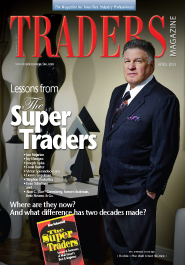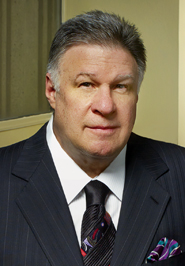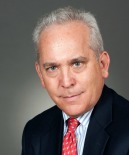They call him “Trader Vic.”
No, he doesn’t run a chain of Polynesian restaurants. But in the same way that chain moved away from its roots in ’60s tiki culture and is now found in once-faraway places such as Dubai or Bangkok, Victor Sperandeo has moved away from trading in equities toward more exotic fare such as commodity futures and the creation of trend indices.

He made his name by appearing to predict a huge market downturn in a Sept. 21, 1987, feature in Barron’s, where he said: “There is a very good chance that this market has topped.”
When the stock market does slip, he said, “program trading will exaggerate the move to such a degree that the sell-off may be the steepest on record.”
Black Monday arrived one month later, with the Dow Jones Industrial Average dropping a record 22.6 percent, or 508 points, on Oct. 19. “Program trading” became the bête noire of the event and a common household villain.
That, and Sperandeo’s track record of being able to spot market trends and gauge risks, made him one of “The Super Traders” profiled in a 1992 book of that name that tried to set out in clear language and human examples the “secrets and successes of Wall Street’s best and brightest” minds. The areas of expertise and perspectives of these minds range from floor trading to institutional trading to market making to program trading and electronic trading.
When the book was published, there were three national markets: the New York Stock Exchange, the Nasdaq Stock Market and the American Stock Exchange. Together, they handled 407.3 million shares of equity trading a day, on average.
On the 20th anniversary of its publication, there were 13 national exchanges where trading occurs in the open, roughly 50 dark pools where firms trade anonymously and scores of internal pools of orders where brokers match trades before they go anywhere else. Average daily volume is 6.6 billion shares a day-and brokers, trading firms and exchanges are cutting back staff, because it’s a down market.
To get a variety of perspectives on the changes that have taken place in the past two decades, Traders Magazine caught up with Trader Vic, former Bear Stearns & Co. chairman Alan C. “Ace” Greenberg and seven of the other eight traders considered the top practitioners on Wall Street back then.
The purpose: To hear, in their own words, how equities trading has changed, how their careers have changed because of it and what lessons they have to offer from the 20 years that have gone by.
The updates on the careers of these nine “Super Traders” and former Bear chairman Greenberg have been compiled by Alan Rubenfeld, author of the original 1992 book issued by Irwin Professional Publishing, and Traders Magazine editor-in-chief Tom Steinert-Threlkeld.
Here’s the story of Victor Sperandeo, who made his name by being able to assess risk-and figure out market trends, as times change.
* * *
Trader Vic has moved far afield from his native New York.

For the last four years, his office has been a stone’s throw north of a Mexican-themed restaurant known as Esparza’s in Grapevine, Texas, just north of the Dallas/Fort Worth International Airport.
Sperandeo moved to digs near the eatery that designates itself as the “Margarita Capital” of Texas because of the lower cost of doing business in the Lone Star State. Particularly, the lower taxes. That increases returns for his clients and himself.
“I’m all about taxes,” he declares, without hesitation. If you’re in the financial capital of the country-Wall Street-you’re getting “maxi-taxed” by the federal government and New York State, he contends. So he came to Texas in 1994.
In the Empire State, taxes on short- and long-term gains take away $38.51 or more of each $100 of profit on trading in futures or equities, by Sperandeo’s calculation. In the Lone Star State, only $30.09 gets taxed away. That leaves more than $8 on each $100 in his or his clients’ pockets.
Now 67, Sperandeo began his career in January 1968 as a trader at Filer Schmidt & Co., in New York, then the nation’s largest dealer in stock options. In the three decades that led up to the Crash of ’87, he traded successfully in stocks, bonds, commodities and currencies.
He launched Ragnar Options, which, for a time, became the largest dealer in options involving over-the-counter securities, before its operations were merged into Weeden & Co. For a short time, he ran a portfolio for George Soros’ Quantum Fund, a hedge fund that in 1992 became famous for “breaking” the Bank of England, with a huge short on the value of Britain’s pound. In 1992, he specialized in trading futures and was a registered commodity trading adviser.
He was known for the methodical method he used to assess market trends and to figure out when to get in and out of stocks.
In the mid-’70s, after missing a stock market low, he spent two years gathering any recorded information he could find on market performance in that pre-personal-computer era. He collected data back to the 1880s.
That allowed him to identify every discernible trend over nearly a century and classify each movement as short-term, intermediate-term or long-term. A “bull market,” he found, amounted to a “broad upward movement with a duration of months to years, lasting 1.8 years 75 percent of the time.” Within those moves, he found that “99 percent of the time,” short-term corrections to the upward trend last two weeks or less and do not exceed 5 percent of the original market capitalization.
Why would that matter? If an “intermediate trend” is also up, then a sell-off in the market of 3 percent in a two-week period would provide “excellent odds” for moving in and capitalizing on the long-term upward movement.
And you’d have time to act on it.
Back then, “you’d hit a stock up and, you know, the result wouldn’t be instantaneous. So the only way to make a living was to know the ticker symbols, so you could read the ticker tape and watch what the reaction would be,” Sperandeo recalled. “I did that for a considerable number of years, while there was a ticker tape and while the computerization of the marketplace was behind the curve.”
By 1986, Sperandeo, however, found that reading the ticker tape on stock price movements “stopped being useful.”
The end came, in his eyes, with the arrival of what quickly became known as program trading: computerized trading in baskets of stocks, based on predetermined conditions. This was not like the algorithmically driven orders used in recent years for high-speed automated trading, but instead was used by mutual funds, for instance, to increase holdings in prescribed ratios or to arbitrage in small price discrepancies.
“Program trading renders normal price movements irrelevant because, at any moment, a program can hit and upset what was once predictable from reading the tape,” he wrote in “The Super Traders.” “It is impossible to second-guess the manipulators and costly to be on the wrong side of their programs.”
By late 1986, he decided he could no longer keep up. And by 2000, he had essentially hung up his hat as an equities trader, although he jumps in on occasion when he sees a clear opportunity.
Instead of trying to compete with program traders or their successors, he set up two companies at the outset in 2000 and 2001.
The first was and is Alpha Financial Technologies, a “financial engineering” firm designed to create steady streams of revenue through the creation and licensing of indices.
The other was and is EAM Partners, which provides advisory services, based on fundamental and technical analysis of movements in stocks, options and futures.
Alpha Financial’s first and flagship index is known as the Diversified Trend Indicator, an index that tracks prices of 24 commodity and financial futures contracts. They are grouped into sectors, as well as “long” and “short” positions. The intent of the design was to capture “the economic benefit derived from both rising and declining trends” in futures markets.
That indicator was licensed to Standard & Poor’s from 2004 to 2009, along with a commodity trends and financial trends equivalent. A foreign-exchange trends indicator and global equity “rotator” index were added later. Now products linked to these indexes have been issued by financial firms ranging from Bank of America Merrill Lynch to UBS to Macquarie Bank and Guggenheim Investments.
When “The Super Traders” was published in 1992, Sperandeo had never had a down year in stock, options or commodity trading. Since the credit crisis, however, the indices he has created have been down more than once-and so would be any funds based on them.
“I have limited discretion in what I do,” he said. Even though the indices he created are designed to capture both up and down movements, choppy markets are losers, he finds.
Indeed, the hundred years of history he has based his trend-watching on no longer apply, he contends.
“The problem is, there never has been a period like this,” he said of the post-credit-crisis years. “And there never was a person in the White House that had the mentality of Barack Obama.”
The mandate that all businesses with 50 employees or more buy the most expensive health insurance available. Increasing marginal tax rates on savings and capital gains. Increased taxes on the nation’s highest earners. The use of federal spending to correct economic wrongs and to “invest” in America. The current president is creating a new form of “capitalism with a welfare state safety net,” in Sperandeo’s assessment.
What has changed, as a result, particularly in equities markets?
“You have stopped the correlation between corporate America and mainstream America,” Sperandeo contends.
Growth in the nation’s gross domestic product does not translate to greater employment. And top-line growth, at corporations or for the nation as a whole, is not what matters.
What makes the difference, across the economy and to create greater earnings, is the firing of staff and even top managers and executives. “Top-line growth has been miniscule,” in Sperandeo’s book.
The Federal Reserve’s board of governors, including chairman Ben Bernanke, have aided, abetted and even created a bubble in stocks. They have done so by keeping interest rates next to zero, long-term, and buying up assets, left and right, in what the Fed calls “quantitative easing.”
The Fed is taking on $3 trillion of risk (on the way to $4 trillion this year, Sperandeo says), with taxpayers holding the bill if the assets go bad. And with its continuing practice of buying bonds to keep interest rates low, which Bernanke assured markets again on Feb. 27 remains in place, “the Fed is stealing from savers,” Sperandeo told Traders.
In effect, “the truth has changed” about what moves markets in general and stocks in particular. “Corporate America is in its own world, a separate world to individuals,” he contended. “And government doesn’t attack corporations because that’s where they get their money. They attack individuals. And all a CEO does is say, ‘OK, I’ve got to pay 10 percent more in tax. I get a 10 percent raise,'” to make up for it.
The five lessons for equities desks, from Trader Vic, in 2013:
1. Disregard macroeconomic factors.
The gross domestic product may only grow at 1 percent a year. Unemployment will stay high. Even Bernanke said it was a “reasonable guess” that it would take until at least 2016 before the jobless rate could get back to 6 percent. Individuals don’t matter. Look for companies with strong earnings and defensible positions, in growing markets.
2. Avoid leverage.
It works against you. See Long-Term Capital Management (1999). See Lehman Brothers and all other major investment banks (2008). Do not lever your positions by any more than $2 of margin for every $1 of actual cash or stock. “You can’t find a smarter group of people, IQ-wise,” than at LTCM, whose founders included Nobel Prize economists Myron S. Scholes and Robert C. Merton, “and they blew up,” Sperandeo noted. Those were leveraged by 25 to 1 when Russia defaulted on government bonds and upset their apple cart.
3. Make sure your potential reward is three times as great as your potential loss.
That three-to-one ratio is the cornerstone of Sperandeo’s trading practices. The highest price for an ounce of gold, to date, is $1,910. The most recent low is $1,550. So if it’s trading at $1,620, you have a potential gain of $290 and a potential loss of $70. Probably worth the risk. The ratio of potential gain is 4:1. Then there’s Apple, trading near a 52-week low of $435. There’s likely an equal chance of going down another $75 as going back up $75. And hard to see it going back up $225. Not worth the risk.
4. Don’t trade “short term.”
Trading short-term “is very difficult because of the high-frequency traders,” in Sperandeo’s book. “It’s the program traders (effect). You just don’t know where they’re going to come from, to match you or beat you.” Even a “Super Trader” can’t win, any longer, on intraday trading unless you have a firm set up for the purpose, with lots of broadband capacity.
5. Don’t invest long-term.
The country is heading toward socialism, in his view. That makes it hard to be a long-term investor, because new business formation (and profit) will be reduced. And even healthy companies will be hurt.
His prime example: Profit for insurance companies in health care “is going out the window,” because of mandatory health care. “The greatest shorts in the world are health care insurance companies. Because they’re going to get screwed,” he said, with a sad laugh.
Which leaves trading for the “intermediate” term-looking a year or two out. “You can say well, the government’s not going to go over the cliff. The government’s going to solve the budget problems,” Sperandeo said.
“And you can assume that the market’s going up,” because the Fed will keep zero interest rates. Plus, it will keep printing money, as needed, to prop up the economy. It’s all about the Fed and liquidity, now, Trader Vic asserts.
What do you trade on now? Not news. Because high-speed traders “scalp” that instantly. Not on historical data and historic market trends, because those same automated traders have digested all those patterns that Sperandeo gathered by hand back in the ’70s and translated them into rules that govern the thousands of orders they send out each second of a trading day.
Bet on political moves, instead. “Politics is the game, now,” he said.
He points to a run-up in oil prices in October … just before the election of a U.S. president. The price of a barrel got up “$96 and there were White House hints we were going to use the strategic oil reserve,” Sperandeo asserted. “All of a sudden, the Saudi prince decided to increase production and oil goes back down $10 a barrel,” to $85 or $84.
Which is where “seeking the truth” comes into play. “You could say, if you were a conspiracy theorist, that this Saudi king just decided that,” he said. “I say that he got a phone call from Obama, who said, ‘Look, I need your help.’ And naturally he’s in office and you’re not going to deny him.”
The new secret for the “Super Traders” of today? Watching the real movers of Wall Street. Who are more likely to be in Washington, D.C., or a corporate boardroom, now.
“The CEOs, the politicians, the Fed, all of whom are politicians,” he said. “They’re all on the side of making stocks go up. Government is manipulating the markets.”
Author, “The Super Traders”

Alan Rubenfeld
After writing “The Super Traders” in 1992, Rubenfeld worked on the sellside of the securities trading industry, spending the majority of his career at Deutsche Bank Securities as a sales trader with its Global Portfolio Trading platform. He is currently working as a salesman in the exchange-traded fund industry.




